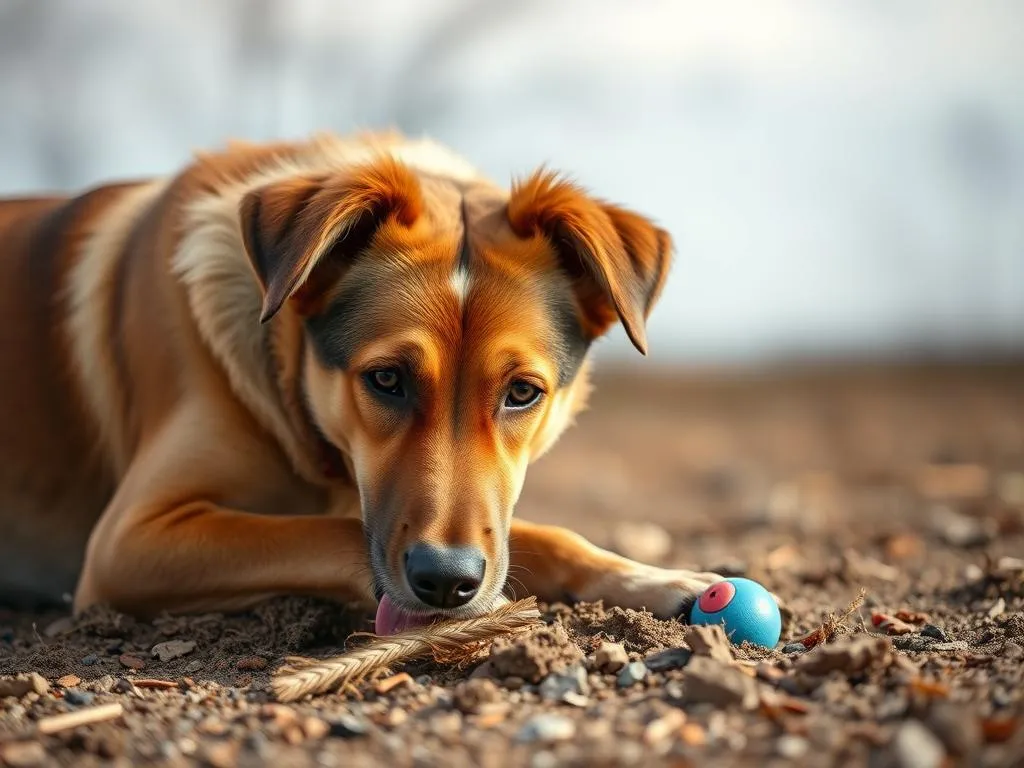
Introduction
Have you ever watched your dog dig furiously at the ground, only to emerge proudly with a toy they had buried earlier? This endearing behavior is a common sight among dog owners. In fact, studies show that over 60% of dogs engage in some form of toy burial. Understanding why dogs bury their toys can offer valuable insights into their instincts and emotional states, enriching the bond you share with your furry friend.
In this article, we will explore the reasons behind this fascinating behavior, shedding light on the instincts that drive it and what it means for your dog’s emotional wellbeing. By understanding these behaviors, you can better cater to your dog’s needs and strengthen the owner-dog relationship. We will cover various aspects, including basic canine instincts, the reasons behind burying toys, when this behavior might pose a concern, how to respond appropriately, and even some fun facts about dogs and their toys.
Understanding Canine Behavior
Basic Instincts
Dogs, as descendants of wild ancestors, possess a complex array of instincts that have been passed down through generations. Their wild forebears, such as wolves, relied heavily on their instincts for survival—be it hunting for food, seeking shelter, or protecting their territory. These instincts still linger in our modern-day pets, shaping their behaviors and interactions with the world around them.
The survival instincts of dogs manifest in various ways, including their propensity to dig and bury objects. This behavior can be traced back to the need for resource management in the wild, where food was cached for later consumption. Understanding this instinctual behavior allows pet owners to appreciate more deeply the motivations behind their dog’s actions.
Natural Behaviors in Dogs
Beyond survival instincts, dogs exhibit a range of natural behaviors that include digging, hunting, and foraging. These actions are not merely playful but are tied to their ancestral ways of life. Much like wolves, who dig to create dens or hide their food, domestic dogs retain these behaviors, even in a safe home environment.
In observing your dog, you may notice them engage in these behaviors when they are excited, bored, or seeking comfort. This connection to their wild ancestors is a crucial element in understanding why dogs bury their toys, as it reflects their instinctual drive to explore and claim their territory.
Reasons Why Dogs Bury Their Toys
Instinctual Behavior
One of the primary reasons why dogs bury their toys is due to instinctual behavior inherited from their ancestors. In the wild, canines would often hoard food and other valuable resources to ensure survival during lean times. This instinct to store items can manifest in domestic dogs as they bury their toys or even treats.
This behavior is tied to their hunting and gathering instincts. When your dog buries a toy, it is akin to their wild ancestors hiding food from scavengers. The act of burying serves a dual purpose: it allows dogs to keep their toys ‘safe’ while also satisfying their innate need to perform these natural behaviors.
Security and Comfort
Another significant factor in why dogs bury their toys is the emotional comfort it brings them. Toys often serve as sources of security and familiarity. When dogs bury their toys, they may be seeking to create a safe space for them. This behavior can also occur during times of stress or anxiety, as burying toys can provide a sense of control and comfort.
Think of it as a form of self-soothing. Just as some people might hold onto a cherished item for reassurance, dogs find comfort in their toys. By burying them, they create a sense of ownership and security, which can be particularly important for anxious dogs.
Play and Exploration
Dogs are inherently playful creatures, and burying toys can simply be part of their play and exploration habits. When dogs engage in this behavior, they may be viewing it as a game, turning the act of burying into an enjoyable activity. This playful aspect is essential for their mental and physical stimulation.
Moreover, burying toys can be a way for dogs to engage their instincts in a fun and interactive manner. It allows them to use their noses and paws, simulating the natural behaviors they would exhibit in the wild. For many dogs, this is not just a task but an engaging activity that contributes to their overall happiness.
Territory Marking
Burying toys can also signify territory marking. Dogs possess keen senses of smell, and when they bury a toy, they are often leaving their scent on it. This scent-marking behavior can serve to establish ownership and signal to other animals that the buried toy is theirs.
For dogs, scent is a powerful form of communication. By burying toys, they can assert their territory and possession, reinforcing their status within the household environment. This behavior is particularly evident in multi-pet households, where competition for belongings may prompt dogs to bury their toys to keep them ‘safe’ from others.
When Is Burying Toys a Concern?
Excessive Burying
While burying toys is generally a normal behavior, excessive burying may indicate underlying issues such as anxiety or stress. If a dog consistently buries toys to the point that it disrupts their daily activities or leads to behavioral changes, it might be a sign of discomfort or unease.
Signs to watch for include:
– Increased frequency of burying
– Changes in appetite or energy levels
– Signs of destructive behavior
– Excessive barking or whining
If you notice these signs, consider consulting with a veterinarian or a professional dog trainer to address the underlying causes of your dog’s behavior.
Health Considerations
Another aspect to consider involves the health implications of burying toys. If a dog buries toys in an environment where they may ingest foreign objects or dirt, it could lead to health complications. The risk of choking or gastrointestinal problems increases if they dig up and chew on contaminated or inappropriate items.
To mitigate these risks, it is essential to provide safe toys and supervise your dog during playtime, especially in outdoor environments. Opt for durable toys that are less likely to break apart, and regularly check the condition of your dog’s playthings.
How to Respond to This Behavior
Encouragement of Natural Behaviors
One way to positively respond to your dog’s instinct to bury toys is to encourage natural behaviors in a safe and controlled environment. Consider creating a designated digging area in your yard where your dog can freely express their instincts without causing damage to your garden or lawn.
Providing a space for digging can also help satisfy their exploratory nature. You can fill this area with soft soil or sand, making it an engaging spot for your dog to enjoy digging and burying their toys.
Providing Proper Toys
Choosing the right toys is crucial for encouraging healthy burying behavior. Opt for toys that are designed for digging or burying, such as plush toys that can be easily hidden, or rubber toys that can withstand the rigors of outdoor play.
Interactive toys that stimulate your dog’s mind can also be beneficial. Consider toys that dispense treats or require problem-solving, as these can keep your dog engaged and provide an alternative outlet for their energy.
Training and Modification
If excessive burying is a concern, basic training techniques can help manage the behavior. Positive reinforcement is essential in redirecting your dog’s focus. For instance, if your dog begins to bury excessively, distract them with a game or an appropriate toy.
Training your dog to respond to commands can also help in modulating their behavior. Simple commands like “leave it” or “come” can be useful tools for managing the urge to bury. Remember to use positive reinforcement when they respond correctly to encourage desired behaviors.
Fun Facts About Dogs and Their Toys
Dogs’ Relationship with Toys
Did you know that the average dog has approximately 20 toys? However, some dogs can be quite particular about their favorites. While soft toys are popular among many breeds, others prefer chew toys or interactive puzzles that challenge their minds.
Understanding your dog’s preferences can enhance their play experience. For instance, working breeds often thrive with toys that require mental engagement, while toy breeds may enjoy smaller, plush items to snuggle with.
Notable Stories and Anecdotes
Dog owners often share heartwarming or hilarious stories about their pets’ burying habits. For example, one owner recounted how their Labrador retriever would bury not only toys but also socks and shoes, leading to a treasure hunt every time they needed to find something.
Another touching story involves a rescue dog who, after being adopted, began to bury toys in the backyard as if claiming the space for themselves. This act provided the dog with a sense of safety and belonging, showcasing the emotional depth behind this behavior.
Conclusion
In summary, the reasons why dogs bury their toys are deeply rooted in their instincts, emotional needs, and playfulness. From instinctual hoarding to seeking comfort and marking territory, this behavior is a fascinating reflection of a dog’s psyche.
Understanding canine behavior enhances not only your appreciation for your pet but also strengthens the relationship you share. By observing these behaviors and nurturing your dog’s natural instincts, you can create a fulfilling environment for your furry companion.
Engage with your dog, provide them with appropriate toys, and create spaces where they can express their instincts healthily and safely. Whether through play, exploration, or comfort, your dog’s happiness is ultimately what matters most.









